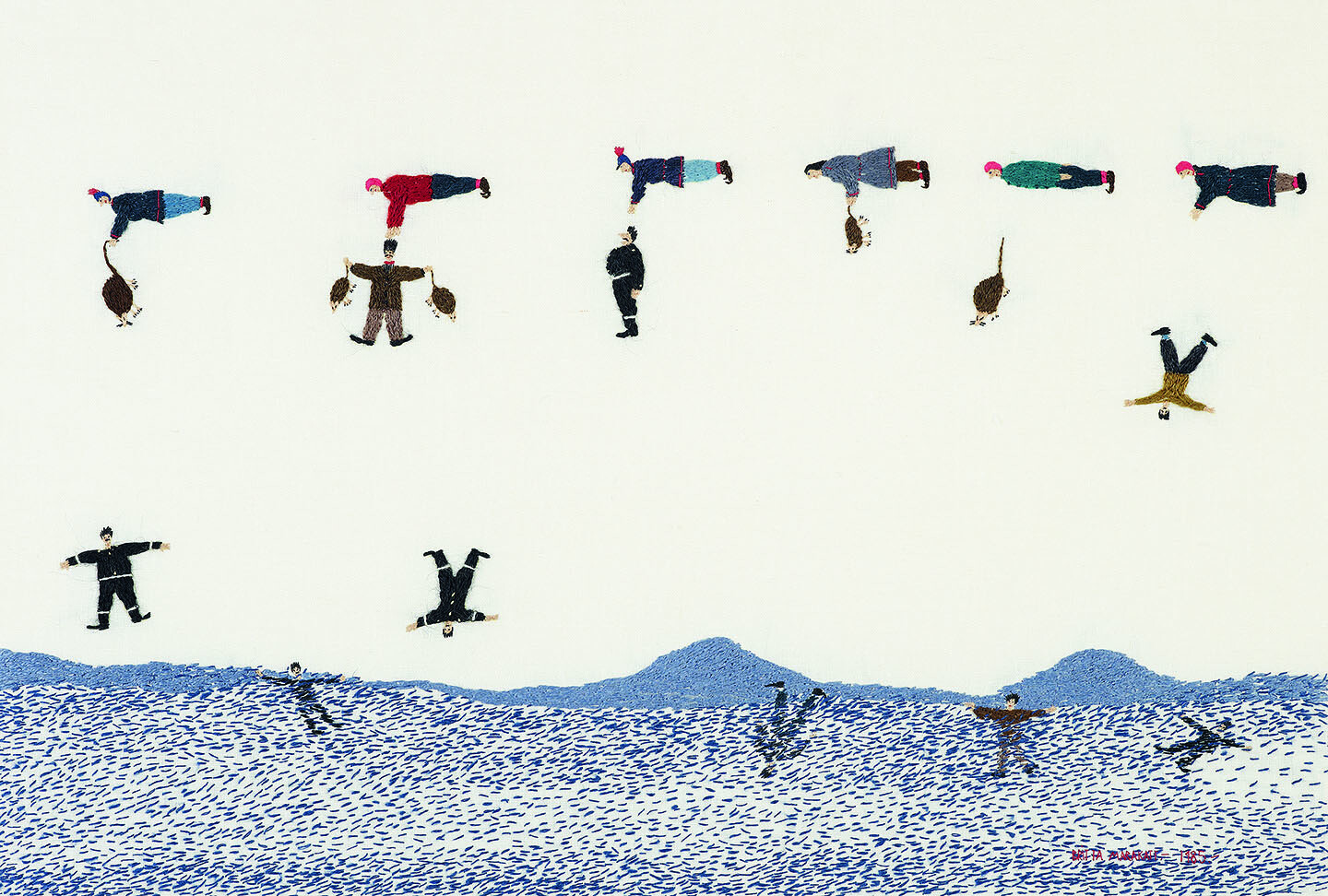History in Stitches
November 17, 2018–January 13, 2019
Lunds konsthall is very proud to present Britta Marakatt-Labba: History in Stitches. This is the first large retrospective south of the Sami lands of the prominent artist’s oeuvre: unique, idiosyncratic and—encouragingly—more appreciated than ever.
Many art professionals discovered Marakatt-Labba’s captivating narrative and visual skills only at documenta 14 in Athens and Kassel last year. They were duly impressed and touched by the 24 metre-long Historjá (History, also known as the Tromsø Frieze), permanently installed in the Light Atrium of the University of Tromsø, the northernmost university in the world.
At Lunds konsthall we now feature a reproduction of this work, which may be called a contemporary history painting (although it is embroidered, and although it is based on oral tradition rather than on recorded knowledge). Just like those 18th- and 19th-century tableaux of coronations, military bravado and other moments of national glory, Marakatt-Labba’s frieze oscillates between the verifiable and the mythical. It produces a convincing composite picture of history that stays etched in our memory, while we are also reminded that this particular history—of her own people—has been kept deliberately invisible.
Other works in the exhibition are also monumental accounts of historical events, but they work differently. Garjját (The Crows, 1983) and Johtin (The Move, 2016) are good examples. The former visualises protests against the damming of the Alta river in Finnmark, northern Norway, in the early 1980s. The latter maps how mining now forces the move of the entire city centre of Kiruna, which was already emblematic of colonial resource extraction in Sápmi. If we add the work Máilmmiviidosaš liegganeapmi (Global Warming, 2009), as we do in the exhibition, we can see the contours of an art practice where social thought and activism support innovative visual solutions and vice versa.
Marakatt-Labba’s themes and her modes of vision connect with Sami reality, but so do her chosen textile techniques: embroidery and appliqué. Her work often converges with what in Northern Sami is called duodji (applied art, design). Gunvor Guttorm writes: “How, then, can I propose that the duodji concept also includes artistic activities? Duodji has had a broad meaning: the process of making, the product itself and its function. In Konrad Nielsen’s dictionary the term is defined as handicraft, finished object and product (in the abstract sense) […] Even today the term duddjot (to make, or practice duodji) is used to describe something that yields results. This may consist of a spoken or written expression, a book, an image, and so on.”[1]
Marakatt-Labba’s embroidered visual stories are, in other words, political in different ways and dimensions. They challenge and expand the notion of art. They resurrect nearly erased memories and critique contemporary life. They foresee and warn against what might happen in her native land—not least now, when the average annual temperature threatens to rise by several degrees.
A smaller version of this exhibition will be shown under the same title at Kohta, a new private kunsthalle in Helsinki, from January 31 until March 17, 2019 and at Västerbottens museum in Umeå, Sweden, from April 7 until June 9, 2019.
We warmly thank Britta Marakatt-Labba for her engaged collaboration, and all the lenders. Apart from the artist herself, the following institutions and individuals have kindly lent their works to the exhibition: Ájtte, Swedish Mountain and Sami Museum, Jokkmokk; KORO, Oslo; Lindbergs Konst & Ramar, Luleå; Luleå University of Technology; the Municipality of Kiruna; the Municipality of Luleå; the Municipality of Umeå; Museum Anna Nordlander, Skellefteå; the National Association Folkets hus och parker, Stockholm; Nordnorsk Kunstmuseum, Tromsø; Norrbottens museum, Luleå; the Prosecution Authority of Luleå; Public Art Agency, Stockholm; Radiotjänst, Kiruna; Region Gävleborg, Gävle; RiddoDuottarMuseat, Karasjok; the Sami School in Troms, Målselv; the Sami School Board, Jokkmokk; the Sami School Board, Kiruna; Trafikanalys, Stockholm; Umeå University; University of Tromsø, the Arctic University of Norway; Egil Utsi, Karasjok. Moreover, Bonniers Konsthall, Stockholm, and OCA Office for Contemporary Art Norway, Oslo, have helped us organize loans and transports.
Notes
[1] Gunvor Guttorm, “Stories Created in Stitches,” in Jan-Erik Lundström (ed.), Broderade berättelser/Embroidered Stories/Sággon muitulusat, p.152 (reprinted in Afterall no.45, 2018, pp.19–23).

